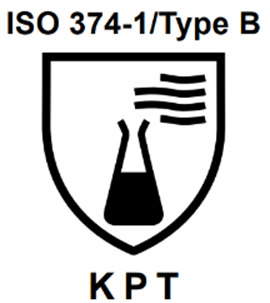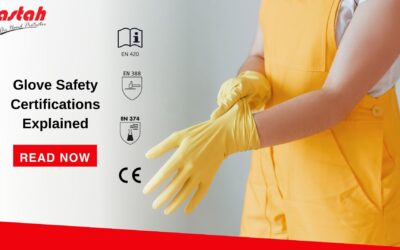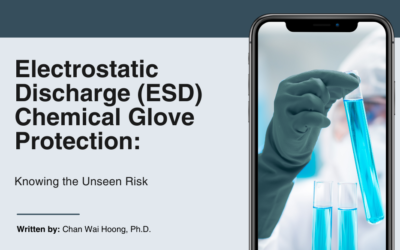Chemical gloves have become increasingly popular after the COVID-19 pandemic, as more people seek household protection.
People are starting to understand how important maintaining cleanliness in the home is. The main use of household gloves is for cleaning and washing.
When it comes to house cleaning, gloves not only play a role in physical protection from dirt.
You need to do washing and cleaning using cleaning agents to complete the job. If you are going to use cleaning chemicals, your gloves should be able to withstand them. This is where EN ISO 374 chemical permeation test comes in.
There are several articles that mention EN ISO 374 chemical permeation certifications and requirements.
Today, let’s discuss something different apart from the certifications.
In this topic, we will discuss EN ISO 374 from the consumers’ perspective.
Common Pain Points When Choosing Chemical Gloves for Household Protection
When a housewife is buying a pair of household gloves, what are they looking at when they pick the glove at a store?
1. A fashionable design on gloves?
2. An attractive colour of gloves?
3. Or the capabilities of chemical protection of the glove?
Obviously, most housewives will choose 1 or 2.
This presents a problem.
They have a mindset of thinking that all the gloves are the same. Whichever glove they choose will be able to help them to complete the household work.
Does it really like that?
Well, this is partially correct.
Do they know what the important criteria are that they must consider before buying a glove?
YES, it is the chemical protection of the gloves. All gloves are not designed the same. This is why the chemical permeation test has come into play.
People are increasingly bothered by the lack of information and understanding of chemical penetration. Chemical permeation refers to a chemical that can penetrate a glove material. Chemicals that penetrated can cause skin irritation, allergic reactions, and even chemical burns. Chemical permeation is tested according to the testing standards in EN ISO 374.
Exploring the EN ISO 374:2016 Standard for Effective Chemical Permeation Testing
The EN374 standard evaluates gloves’ ability against chemical penetration through the glove.
In this test, the glove material exposes to a specific chemical for a specific period of time. Then, the amount of chemical that permeates the material is measured.
When a glove is certified under EN ISO 374, it is marked with a chemical permeation symbol as shown below:

The three CODE LETTER below the EN ISO 374 logo represent chemicals that have been tested on the gloves.
The chemical permeation test is based on the code letters in EN ISO 374.
Below is a list of the chemicals represented in EN ISO 374. This has provided guidelines on how chemicals are tested on the gloves.

The classification of results is based on a performance level from 1 to 6.
Level 1 is the lowest permeation level , while Level 6 is the highest chemical permeation level .
The chart below shows how to interpret the chemical permeation level.
| Breakthrough Time (in minutes) | Performance Level |
| > 10 | Level 1 |
| > 30 | Level 2 |
| > 60 | Level 3 |
| > 120 | Level 4 |
| > 240 | Level 5 |
| > 480 | Level 6 |
Chemical resistance is an important consideration when choosing chemical-handling gloves.
Each chemical has a different level of resistance. Read more about the EN ISO 374 standard for chemical resistant gloves.
It is important to understand that not all gloves marketed as chemical-resistant gloves meet the EN374 standard.
Consumers mistakenly believe they are protected by the gloves they are having. Besides, consumers may not even be aware of the EN ISO 374 standard. This can lead to a false sense of security when using PPE.
Solutions for Selecting Chemical Household Gloves with Optimal Chemical Protection
When you are selecting household gloves, it is vital to consider their chemical resistance.
The EN ISO 374 standard is globally recognized for evaluating glove chemical penetration resistance. Gloves must provide a minimum level of protection from chemical penetration.
To choose a suitable household glove using EN ISO 374, follow these steps:
1. Identify the chemicals you will expose to.
2. Select gloves that have tested against the specific chemicals.
3. Check the glove’s permeation breakthrough time (BTT), which is the time it takes for a chemical to penetrate the glove material. The longer the BTT, the better the protection.
4. Choose gloves that meet the performance level required for your task.
Nastah’s EN ISO 374 – Certified Household Gloves: A Trusted Solution for Reliable Chemical Permeation Protection
In Nastah, we have tested our gloves based on the latest ISO EN ISO 374:2016.
For example, our FL2 and FL3 household gloves have passed on EN ISO 374: 2016 Type B. It means that we have tested 3 chemicals on our gloves.
The chemicals that we have tested are under code letters K, P, and T. The chemicals tested represent the chemicals that consumers use daily. This provides greater protection to consumers and their hands.
However, what do K,P,T chemicals used in household products?
The below diagram shows the summary for ease of reference.
| Code Letter | Chemicals | Common Name | Applications in Household Products |
| K | Sodium Hydroxide 40% | Lye | Drain cleaner |
| P | Hydrogen Peroxide 30% | Oxygenated water | Hair bleach, medical first aid cleaning agent, gardening weed killer, and pet litter cleaner |
| T | Formaldehyde 37% | Formalin | Paint, lacquer, clear coat paint, primer |
Now you understand more about what are the chemicals that you are handling and the types of household gloves that protect your hands.
Want to know more about chemical permeation on household gloves, contact us for more information. We are happy to lead you to the correct glove selection.





